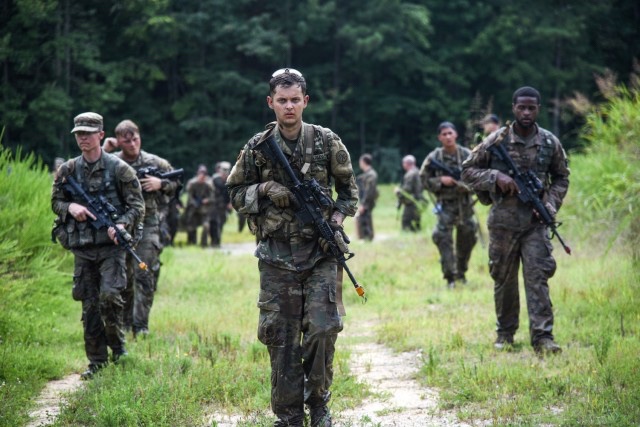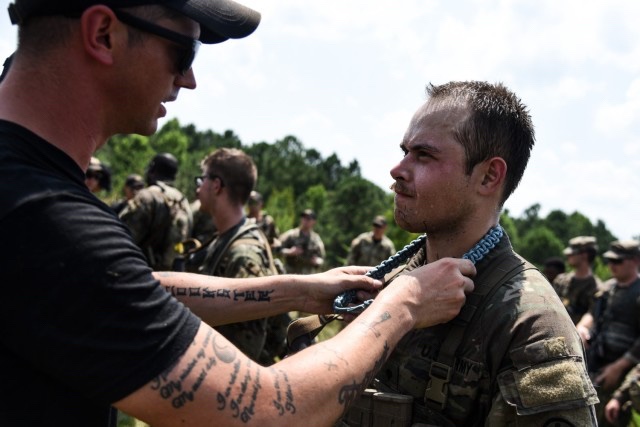
FORT BARFOOT, Va. — A few times each year, the Virginia National Guard’s 1st Battalion, 183rd Regiment, Regional Training Institute, conducts an 11B Infantry Transition Course.
Some of the Soldiers who attend the course, all junior Soldiers and noncommissioned officers, want to test themselves. Others are fulfilling childhood dreams or chasing promotion opportunities. Whatever their reason, their goal is singular: to earn the 11B military occupational specialty and leave Fort Barfoot with a blue infantry shoulder cord.
“It is not an easy MOS, but it is a very rewarding one at the same time,” said Sgt. 1st Class Brian Cook, a long-time cadre member at the 183rd RTI.
During the course, Cook and the rest of the cadre put Soldiers, who arrive as engineers, medics, intelligence analysts and mechanics, through three rigorous weeks of infantry training. Soldiers gain proficiency on weapons, improve their land navigation skills, learn how to communicate and move effectively across a battlefield. The days are long and often made more challenging by sweltering heat and humidity.
The challenge of becoming an infantryman motivated many of the students as they worked their way through the course.
“The reason I wanted to become an 11B is because I like to put myself to the test,” said Staff Sgt. Patrick Powers, a 91B wheeled vehicle mechanic in the Virginia National Guard. He said the course would also help prepare him for his next challenge, U.S. Army Ranger School.
Sgt. Allison Stanton, assigned to the 82nd Airborne Division as a 35F intelligence analyst, was also there to challenge herself.
“I wanted to become at 11B because it’s really the only MOS that I felt was out of my comfort zone,” she said. “I felt like the whole job would be very challenging for me, so that’s why I chose it.”

Spc. Alexander Wyatt started his military career as an infantryman in the U.S. Marine Corps. He was discharged due to an injury but rehabilitated himself and worked on an ambulance while out of the military. When he joined the Army, he returned as a 68W combat medic but felt pulled toward the infantry.
“I wanted to become an infantryman because it’s always been a dream of mine. I just always had the itch to still be an infantryman, and I finally scratched that itch,” Wyatt said. He’s now assigned to the 75th Field Artillery Brigade at Fort Sill, Oklahoma.
Spc. Steven Schmidt drove across the country to attend the infantry transition course. He started his military career as a medic.
“During my time in the military, I’ve met all sorts of people with different MOSs, but the 11Bs stood out to me in their brotherhood,” Schmidt said. “I’ve always believed that going through difficult times is what brings people together, and I think 11Bs go through that more than any other MOS. I just wanted to be a part of that.”
As the most recent course came to a close, after the Soldiers hauled themselves, their gear and their weapons through the forests, roads and fields of Fort Barfoot, after they tested their endurance with a timed 5-mile run and sent thousands of rounds down range from a variety of weapons systems, they gathered near a small pond. The cadre, decorated with an assortment of badges, tabs and scrolls, formed a corridor through the water. Tired and dirty from days spent in the field, the students were called forward into the water, guided through the protected passage formed by the cadre. Then, dripping pond water and steaming in the midday sun, they worked their way to the top of a hill.
The immersion and ascent served to mark the transition from what they were before to what they had become.
On top of a Fort Barfoot hill on July 26, 2023, 22 Soldiers received their blue infantry cords and officially became the newest infantry Soldiers in the U.S. Army.
By SFC Terra C. Gatti, Virginia National Guard Public Affairs Office


“” Sgt. Allison Stanton, assigned to the 82nd Airborne Division as a 35F intelligence analyst, was also there to challenge herself.””
–
There’s Females in Infantry now?
Infantrywoman?
So the Army has already invested in her for a Top Secret clearance and she had to complete a six month AIT for her to give that up to be an 11B? Or did she just do the course for funzies?
If it’s anything like in the 90’s, Intell Analysts are hard to come by and there’s no way Division would just let one go be Infantry.
Yes, women can join the infantry now. They’ve been able to for some time I believe, although I’m unsure of the exact date.
Although I will say the first time I saw a female on Ft. Benning (sorry, Moore) rocking a blue cord, it kinda threw me for a loop.
Two week wonder course, I had a Plt Sgt in Iraq that went to one of those courses to get his E7. Nice guy but not a very good leader
The AIT portion of Infantry OSUT is 3 weeks. At least they are running this course. I had a squad leader who reclassed from NBC NCO to 11B without ever having any sort of training, and another NCO in my Infantry unit did the same, both were perfect reasons to run a course of any sort.
Having formative years as lower enlisted in the Infantry, in my opinion, is paramount to becoming a good infantry leader, though there are exceptions.
Jon, agreed on all points.
I have met some soldiers that have gone there this course and have become very good infantry leaders. I have a close friend the was a combat MP and reclassed into the PA Guard as infantry. Now my former PLT SGT background was maintenance/transportation.
It takes a certain mentality to be a good NCO, not only in the military but also in the Infantry. Not really having a background in mission planning or basic infantry skills really hurt my Plt Sgt. Like I said nice guy but was way behind the 8ball when it came to his infantry skills.
“….through three rigorous weeks of infantry training…”
It’s still three weeks, if you read the article